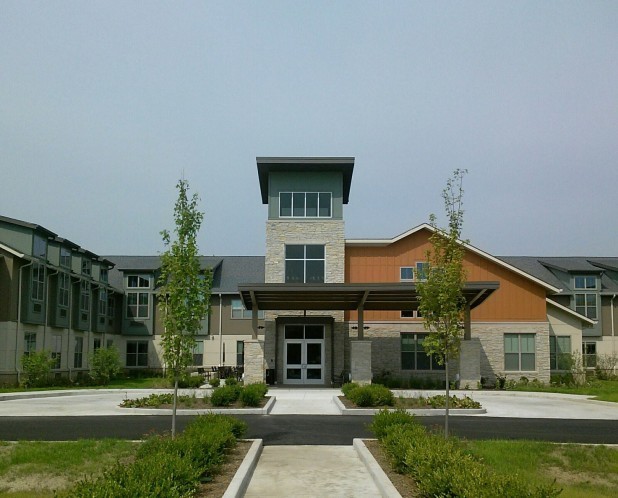HCN’s New Big Bet on PostAcute Care Signals Industry Sea Change Senior Housing News
Post on: 20 Август, 2015 No Comment

Health Care REIT (NYSE: HCN) has long invested in skilled nursing properties, but the REIT’s recent $1.4 billion partnership with Mainstreet signals a shift in the investors strategy of late that’s representative of a much larger transition for health care in general.
More specifically, the investment points to broader change on the horizon for skilled nursing as the industry has known it for the past five decades.
Last month, HCN entered into the partnership with Mainstreet — the largest developer of senior housing and post-acute facilities in the U.S. — to acquire 17 properties currently under construction for $369 million and another 45 properties in the Carmel, Indiana-based developer’s future pipeline, representing a $1 billion acquisition and $2.3 billion in total.
Mainstreet’s Next Generation communities each feature a mix of 70 post-acute beds and 30 assisted living beds, high-end common areas and amenities, private rooms and baths, and rehabilitation therapy space.
The property type is arguably unique in an industry that has traditionally focused on skilled nursing as being primarily long-term care with a wing of post-acute care. But the market appears to be deviating from this model, as skilled nursing as a whole faces an uncertain future. plagued by negative operating margins and reimbursement risk.
Instead, there has been a bifurcation of skilled nursing into long-term care and post-acute care, some say.
“Skilled nursing historically has always been synonymous with long-term care,” says Mainstreet Founder and CEO Zeke Turner. “Over time you had the emergence of assisted living and independent living and other categories to fulfill more residential functions, leaving more of the medical piece to long-term care. For the last 25 years, people have been saying we need something new in skilled nursing. Over the last year or so that’s become clear: There’s been a bifurcation in skilled nursing between short-term rehab/therapy and long-term medical residence.”
With the second-largest health care REIT backing the post-acute model, it seems HCN is betting big on the segment dominating the skilled nursing space in the coming years, despite what others might identify as hefty risks.
“Were attracted to these properties because they are typically the lowest cost alternative for Medicare and managed care patients,” says Scott Brinker, chief investment officer of HCN. “The importance of cost efficiency will only increase going forward. Reimbursement rates fluctuate over time, so when we invest in these types of properties, we structure them as triple-net leases with a large payment coverage cushion to insulate our rent payment from changes in reimbursement rates.”
Mainstreet’s model allows HCN the opportunity to invest in a segment of skilled nursing that has remained largely untouched by health care REITs, become a player in the accountable care organization (ACO) landscape, and extend its network of third-party operators.
HCN’s Big Bet on the “New” Skilled Nursing
Though HCN has invested in post-acute properties for years including partnerships with operators Genesis and Trilogy among them, Mainstreet’s properties offer a unique mix of post-acute and assisted living suites, which differs from traditional skilled nursing portfolios.
“This partnership with Mainstreet allows us to deliver a product that is in high demand yet short supply,” Brinker says. “One-third of the units in these properties are private-pay assisted living, which serve as a complementary step-down unit for the post-acute patients. Meanwhile the on-site post-acute services, such as rehab therapy, allow the assisted living residents to receive services that are otherwise rarely available in an assisted living setting.”
But HCN’s big bet lies on a largely untested — and higher-risk — model. While other models of senior housing have long track records of proven success, Mainstreet’s property type is unique in that it is a relatively new product and there isn’t anything quite like it in the market. Because of this, some analysts say the investment still comes with its share of risk.
“The Mainstreet [properties] really are different,” says Rob Mains, research managing director at Stifel Financial Corp. “The two reasons I dont think everyone will go after that are: one, since its medically complex, and [two], you are making a bet on where health care delivery evolves. … Not everyone is willing to make those two bets.”
While Mainstreet’s 45-property future pipeline will offer a first purchase option to HCN, other investors are expected to follow with their own moves in the post-acute space.
“There’s going to have to be investment into this category,” Turner says. “Right now, we’re the only development group of any note focusing on this area; I expect this to change at some point. Over time, within three to five years, there will be others that will play into this space — it’s just a matter of time before people get there.”
When this time comes, there will be a move away from investing in the costly, Medicaid-reimbursed long-term care segment of skilled nursing, to private pay or Medicare-reimbursed post-acute care, experts say.
“We will continue to see a trend away from Medicaid and that’s really what’s desirable from the standpoint of the Big Three,” says Kevin Tyler, analyst with Green Street Advisors. “They’re looking for higher quality mix so that means more private pay and Medicare on a skilled nursing basis.”
What HCN’s Deal Means to ACOs
By investing in these Mainstreet properties, HCN also is becoming a major player in the ACO landscape.
“The exact details of ACOs will take many years to play out, but we believe there are a few certainties,” Brinker says. “One, the need for efficient outcomes. The Mainstreet properties allow patients to leave the hospital and enter a lower cost setting where they get highly focused services.”
Post-acute care — with its rehab and go home model — is largely designed to help improve patient outcomes and reduce hospital readmissions, a central focus of ACOs, set forth by the Affordable Care Act (ACA).
By having post-acute care with the option to move residents to an on-site assisted living suite, the Mainstreet properties are well-positioned to attract recently discharged patients.
“This is unique and we probably will continue to see it as a trend in skilled nursing, where there’s more of a focus on post-acute with a component of assisted living rather than long-term care,” says Tyler, of Green Street Advisors.

Senior living operators have made a concerted effort to figure out the best strategies for establishing themselves as partners in ACOs. Some rely on diversified service offerings across the post-acute care continuum, while others are building near existing hospitals and health systems to carve out their niches in the ACO fold.
Though strategies vary, one thing is clear in this space: Size matters. The need for scale is essential, Brinker says.
“Large operators will be better equipped to invest into infrastructure and to contract with managed care payers,” he says. Mainstreet, as the largest developer of senior housing and post-acute facilities in the U.S. has a sizable hold on the market, not to mention access to several large-scale operators such as Life Care Services, which has more than 115 properties.
Finally, Mainstreet’s upscale Next Generation design sets a precedent for future post-acute properties with its high-end amenities and private rooms and baths.
“What’s nice about post-acute care is the hospitals like it,” Turner says. “It’s also much more efficient when it comes to cost. And if the properties are designed well, then the consumer also finds the product desirable.”
The need for high-quality real estate is a certainty in the ACO landscape, Brinker says.
“Consumers increasingly have a choice in health care. Shared rooms and low-quality food will not be acceptable to consumers who have a choice. The Mainstreet properties cater to consumers who have a choice,” he says.
Sourcing Future Growth Today
HCN’s Mainstreet partnership may signal forthcoming industrywide trends that could shift health care REITs’ investment strategies in the future, making them bigger players in the U.S. health care system as a whole. But the deal also provides HCN another definitive advantage: access to senior housing operators.
REITs have long attributed their performance to working with strong, stable operators. Some of HCN’s partnerships include Benchmark, Sunrise and Brookdale Senior Living. Through the 62-property deal with Mainstreet, however, HCN will have access to new operators and, potentially, future properties through those partnerships.
“This partnership with Mainstreet expands our existing relationships with Genesis and Trilogy and establishes new relationships with well-respected operators such as Ensign and Life Care Services,” Brinker says. “We own the highest-quality, most modern properties in the sector. These properties will stand the test of time, allowing us to deliver superior internal growth.”
Growth won’t be hard to come by with 45 properties in Mainstreet’s future pipeline. Partnering with a developer was a strategic move that will give HCN access to a steady stream of properties in the future.
“The overall transaction was really consistent with Health Care REIT’s overall strategy in terms of working with their operating partners,” Tyler says. “I think it’s a great deal in that what they’ve effectively created is a way for them to source future growth, and that’s something that’s been on everyone’s mind. By partnering with a developer you’ve got the opportunity to do that at the price you’ve set today.”














